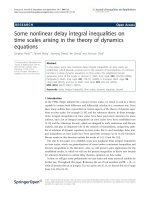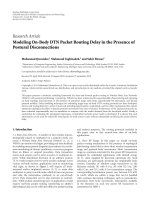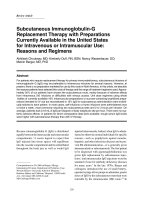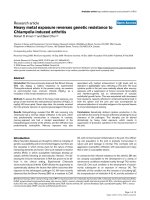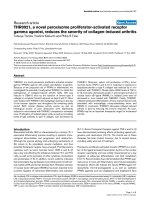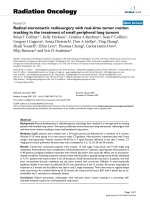Báo cáo y học: "Cigarette Smoke Exposure Alters mSin3a and Mi-2α/β Expression; implications in the control of pro-inflammatory gene transcription and glucocorticoid function" pdf
Bạn đang xem bản rút gọn của tài liệu. Xem và tải ngay bản đầy đủ của tài liệu tại đây (1.58 MB, 7 trang )
Marwick et al. Journal of Inflammation 2010, 7:33
/>Open Access
RESEARCH
© 2010 Marwick et al; licensee BioMed Central Ltd. This is an Open Access article distributed under the terms of the Creative Commons
Attribution License ( which permits unrestricted use, distribution, and reproduction in
any medium, provided the original work is properly cited.
Research
Cigarette Smoke Exposure Alters mSin3a and
Mi-2α/β Expression; implications in the control of
pro-inflammatory gene transcription and
glucocorticoid function
John A Marwick*
1,2
, Christopher S Stevenson
3
, Kian Fan Chung
1
, Ian M Adcock
1
and Paul A Kirkham*
1,2
Abstract
Background: The key co-repressor complex components HDAC-2, Mi-2α/β and mSin3a are all critical to the regulation
of gene transcription. HDAC-2 function is impaired by oxidative stress in a PI3Kδ dependant manner which may be
involved in the chronic glucocorticoid insensitive inflammation in the lungs of COPD patients. However, the impact of
cigarette smoke exposure on the expression of mSin3a and Mi2α/β and their role in glucocorticoid responsiveness is
unknown.
Methods: Wild type, PI3Kγ knock-out (PI3Kγ
-/-
) and PI3K kinase dead knock-in (PI3Kδ
D910/A910
) transgenic mice were
exposed to cigarette smoke for 3 days and the expression levels of the co-repressor complex components HDAC-2,
mSin3a, Mi-2α and Mi-2β and HDAC-2 activity in the lungs were assessed.
Results: Cigarette smoke exposure impaired glucocorticoid function and reduced HDAC-2 activity which was
protected in the PI3Kδ
D910/A910
mice. Both mSin3a and Mi-2α protein expression was reduced in smoke-exposed mice.
Budesonide alone protected mSin3a protein expression with no additional effect seen with abrogation of PI3Kγ/δ
activity, however Mi-2α, but not Mi-2β, expression was protected in both PI3Kδ
D910/A910
and PI3Kγ
-/-
budesonide-treated
smoke-exposed mice. The restoration of glucocorticoid function coincided with the protection of both HDAC activity
and mSin3a and Mi-2α protein expression.
Conclusions: Cigarette smoke exposure induced glucocorticoid insensitivity and alters co-repressor activity and
expression which is prevented by blockade of PI3K signaling with glucocorticoid treatment. Inhibition of PI3Kδ
signalling in combination with glucocorticoid treatment may therefore provide a therapeutic strategy for restoring
oxidant-induced glucocortiocid unresponsiveness.
Introduction
Gene transcription is tightly regulated by a highly com-
plex and dynamic set of processes central to which is the
recruitment of co-repressors to promoter bound
sequence specific transcription factors [1-3]. Two of the
major co-repressor complexes in mammalian cells are the
mammalian Sin3a (mSin3a) and Mi-2/nucleosome
remodelling and deacetylase (NuRD) complex, both of
which are ubiquitously expressed [2,4-6]. The mamma-
lian genome encodes two Mi-2 proteins; Mi-2α (encoded
by the Chd3 gene) and Mi-2β (encoded by the Chd4
gene). Although the latter is predominantly associated
with the NuRD complex they are structurally similar and
no functional or cell type specific differentiation between
Mi-2α and Mi-2β has yet been made [6].
Both the mSin3a and Mi-2/NuRD co-repressor com-
plexes are large multi-component complexes in which not
all of the components and their functions have been iden-
tified [2,6]. However, two of the key components include
histone deacetylases 1 and 2 (HDAC1/2) and methyl
transferases (including methyl-CpG-binding proteins)
* Correspondence: ,
1
Section of Airways Disease, National Heart & Lung Institute, Imperial College
London, UK
2
Respiratory Disease Area, Novartis Institute for Biomedical Research, Horsham,
UK
Full list of author information is available at the end of the article
Marwick et al. Journal of Inflammation 2010, 7:33
/>Page 2 of 7
[2,7]. These are used to manipulate the basal transcrip-
tional machinery and the chromatin structure through
altering their acetylation and methylation status and
thereby regulating gene expression [8]. In addition, Mi-2
possesses an ATPase-dependant nucleosome remodelling
capacity and mSin3a can recruit sequence specific
repressive transcription factors such as Krüppel-like tran-
scription factor (KLF) 11 [4,9].
HDACs are central in the regulation of pro-inflamma-
tory gene transcription mediated by nuclear hormone
receptors including the glucocorticoid receptor α (GRα)
[10-15]. HDACs function by deacetylating of key compo-
nents of the transcriptional machinery including the core
histone proteins resulting in their in re-association with
the DNA, thus presenting a transcriptionally closed con-
formation [1,16].
HDAC-2 function is impaired by oxidative stress which
may be critical in the development of the uncontrolled
chronic and relatively glucocorticoid insensitive inflam-
mation seen in the lungs of patients with chronic obstruc-
tive pulmonary disease (COPD) [11,17-19].
The impact of oxidative stress on key components of
the co-repressor complexes have only just started to be
explored, with the very recent publication highlighting
the impact of oxidative stress driven protein kinase-CK2
activation on co-repressor activity and HDAC2 function
[20]. Nevertheless, the impact is still largely unknown but
may be important for the development of both uncon-
trolled inflammatory responses and the impairment of
glucocorticoid function. In addition, we previously dem-
onstrated that abolition of PI3K signalling restores both
HDAC activity and glucocorticoid responsiveness in
smoke exposed mice [21]. The impact of PI3K signalling
on other components of GR-associated co-repressor
complexes is also unknown.
In this study we look at the impact of cigarette smoke
exposure on the expression of HDAC-2, mSin3a and Mi-
2α/β in the lungs of mice. We also use PI3Kγ knock-out
(PI3Kγ
-/-
) and PI3K kinase dead knock-in (PI3Kδ
D910/
A910
) transgenic mice to assess the impact of PI3K signal-
ling on these components and correlate these with the
restoration of glucocorticoid function.
Materials and methods
Cigarette smoke induced GC insensitive mouse model.
Studies described herein were performed under a Project
License issued by the United Kingdom Home Office and
protocols were approved by the Local Ethical Review Pro-
cess. Both PI3Kδ kinase dead knock-in (PI3Kδ
D910A/D910A
)
or PI-3Kγ knockout (PI3Kγ
-/-
) mice have been described
previously [22,23]. Wild type (BALB/c; wt) and PI3Kγ
-/-
and PI3Kδ
D910A/D910A
mice were exposed to either ciga-
rette smoke (5x1R3F cigarettes/day) or room-air on 3
consecutive days as previously described [24] and dosed
with either budesonide (1 mg/kg) or vehicle (saline with
2% NMP) by intranasal (i.n.) administration one hour
prior to exposure. Air exposed animals were subject to
the exact treatment conditions and regime as smoke
exposed. The budesonide dose was selected that inhibits
ovalbumin induced lung inflammation [25]. Animals
were sacrificed 24 hours post last exposure and tissue
processing were performed as previously described [21].
Protein extraction and Immunoblotting
Cytosolic proteins were extracted using a hypotonic lysis
buffer (10 mM Tris HCl pH6.5, 0.5 mM Na Bisulfite, 10
mM MgCl
2
, 8.6% sucrose, 0.5% NP-40 phosphatase inhib-
itors and protease inhibitors). Nuclear proteins were
extracted using a high salt extraction buffer (15 mM Tris
HCL pH 7.9, 450 mM NaCl, 10% glycerol, phosphatase
inhibitors and protease inhibitors) and nuclear extract
salt concentrations normalised with 2 volumes of a Tris-
glycerol buffer (15 mM Tris HCL pH 7.9, 10% glycerol,
phosphatase inhibitors and protease inhibitors). Protein
quantification was assessed by BCA assay (Perbio, Nor-
thumberland, UK). Immunoblotting and immunoprecipi-
tation was performed as previously described [26]. All
blots were stripped and re-probed for loading controls as
previously described [26].
ELISA and HDAC Activity
Both KC ELISA (RnD Systems, Adingdon, UK) and
HDAC-2 activity assays (Biomol International, Exeter,
UK) were performed using commercially available kits
according to the manufacturer's instructions as previ-
ously [21].
Reagents
All reagents were purchased from Sigma-Aldrich (Sigma-
Aldrich, Gillingham, UK) unless otherwise stated. Phos-
phatase inhibitor cocktail II (Merck Biosciences, Notting-
ham, UK); Protease inhibitors: Complete mini cocktail
inhibitor tablets (Roche Applied Science, West Sussex,
UK) HDAC-2 antibody (Santa Cruz Biotechnology, CA,
USA); mSin3a antibody (Abcam, Cambridge, UK); Mi2α/
β antibody (Austral Biotechnology, San Ramon, CA,
USA); Lamin A/C antibody (Santa Cruz); GAPDH
(Abcam).
Statistical Analysis
Data was analysed by 1 way ANOVA to determine statis-
tical significant variance between the groups for each
endpoint assessed. Statistical significance between
groups was then calculated using the non-parametric
Mann-Whitney U-test. All statistical analysis was per-
formed using GraphPad Prism software using and data is
expressed as mean ± SEM, differences were considered
significant if p < 0.05.
Marwick et al. Journal of Inflammation 2010, 7:33
/>Page 3 of 7
Table 1: Lung HDAC2 activity and KC expression in smoke-exposed mice
wt
PI3Kγ
-/-
PI3Kδ
D910/A910
Sham Smoke Smoke +
Budesonide
Sham Smoke Smoke +
Budesonide
Sham Smoke Smoke +
Budesonide
Lung HDAC-2 activity (% sham) 100 53.4 ± 6.5*** 53.6 ± 8.2 100 61.1 ± 6.9*** 39.9 ± 3.5## 100 104.6 ± 7.3 124.7 ± 10.5
Lung KC expression (pg/mg protein) 180.1 ± 12.7 1357.2 ± 162.8*** 1346.1 ± 98.1 183.5 ± 5.7 1947.1 ± 215.3*** 1777.5 ± 192.6 298.2 ± 91.6 2017.5 ± 246.6*** 1030.8 ± 49.6###
This table summarises key published data from the cigarette smoke-mediated glucocorticoid insensitive model (20). This data demonstrates that reduction in budensonide-mediated repression of
KC is impaired the smoke-exposed animals. Abolition of PI3Kδ, but not γ signalling, restored budesonide function. This coincided with the protection of the activity of the key co-repressor HDAC-
2. **p > 0.01, ***p > 0.001 (versus sham control) ##p > 0.01, ###p > 0.001 (versus smoke-exposed without budesonide).
Marwick et al. Journal of Inflammation 2010, 7:33
/>Page 4 of 7
Results
Cigarette smoke-mediated reduction in HDAC-2 activity
but not expression is associated with relative glucocorti-
coid insensitive inflammation in the lungs. We have pre-
viously reported that cigarette smoke exposure reduced
lung HDAC-2 activity and increased lung KC levels using
the same animals and samples as used in this current
study [21] (Table 1). Budesonide treatment (1 mg/kg) had
no impact on the expression of KC in the lungs of the
smoke-exposed or sham-exposed mice (Table 1) [21]
demonstrating that the cigarette smoke-mediated inflam-
matory response in the lungs of the mice was relatively
insensitivity to glucocorticoids. PI3Kγ abolition had no
impact on HDAC-2 protein expression, activity or KC
levels in the lungs of the smoke-exposed animals. How-
ever, selective abolition of PI3Kδ signalling protected
against smoke-induced attenuation of HDAC-2 activity
and enabled glucocorticoid mediated reduction of Lung
KC levels (Table 1) [21].
Cigarette smoke exposure reduces mSin3a expression.
The expression of mSin3a protein was reduced by around
60% in the lungs of smoke-exposed wt animals as com-
pared to sham-exposed animals wt (P < 0.001) (figure 1).
Although budesonide treatment had no impact on
HDAC-2 activity (Table 1), the expression of mSin3a pro-
tein was elevated by ~40% (P < 0.001) in the lungs of
smoke-exposed wt animals treated with budesonide as
compared to smoke-exposure alone (figure 1). There was
no significant difference in the expression of mSin3a pro-
tein in the lungs of sham-treated PI3Kγ
-/-
or PI3K
D910/A910
mice as compared to sham-treated wt mice (figure 2).
There was also no difference in the reduction of mSin3a
protein expression in the lung of PI3Kγ
-/-
mice or
PI3K
D910/A910
mice either with or without budesonide
treatment as compared to smoke exposed WT (figure 2).
Cigarette smoke exposure alters Mi-2α and Mi-2β
expression. Consistent with the protein expression of
mSin3a, the protein expression of Mi-2α was reduced by
~50% in the lungs of smoke-exposed wt animals as com-
pared to sham-exposed wt animals (P < 0.001) (figure
3A). However, contrary to mSin3a expression, budes-
onide treatment had no impact on Mi2α protein expres-
sion in the lungs of smoke-exposed wt animals. In
contrast, the protein expression of Mi-2β in the lungs of
cigarette smoke-exposed wt animals was elevated by
~100% (P < 0.001) as compared to sham-exposed wt ani-
mals (figure 3B). Again, as for Mi-2α, the protein expres-
sion of Mi-2β in the lungs of smoke-exposed wt animals
was unaffected by budesonide treatment (figure 3B).
There was no difference in the basal Mi-2β protein
expression in the lungs of both PI3Kγ
-/-
and PI3K
D910/A910
mice as compared to sham-exposed wt mice (figure 4).
Furthermore, there was no difference in the elevation of
Mi-2β protein expression in smoke-exposed lungs of
either PI3Kγ
-/-
or PI3K
D910/A910
mice with or without
budesonide treatment as compared to smoke exposed wt
animals with or without budesonide treatment (figure 4).
Similar to the observed data with Mi-2β, there was no
alteration in the either the basal expression or cigarette
smoke-mediated reduction in Mi-2α protein in the lungs
of PI3Kγ
-/-
and PI3K
D910/A910
mice as compared to wt
sham controls (figure 4). However, budesonide treatment
Figure 2 Cigarette smoke exposure reduces lung mSin3a expres-
sion and is not protected by abolition of PI3Kγ/δ signalling in the
absence of budesonide treatment. Data represents the mean ±
S.E.M (n = 7-8). *** p > 0.001 compared to air exposed sham. Abbrevi-
ations; Smoke: Smoke Exposed; Bud: Budesonide.
Figure 1 Cigarette smoke exposure reduces lung mSin3a expres-
sion which is protected by glucocorticoid treatment. Budesonide
treatment protected the lung expression of mSin3a in smoke exposed
animals. Data represents the mean ± S.E.M (n = 7-8). *** p > 0.001 com-
pared to air exposed sham. Abbreviations; Smoke: Smoke Exposed;
Bud: Budesonide.
Marwick et al. Journal of Inflammation 2010, 7:33
/>Page 5 of 7
protected against the down regulation of Mi2α protein in
the lungs of both PI3Kγ
-/-
and PI3K
D910/A910
smoke-
exposed mice compared to smoke exposed wt controls
(Figure 4). The levels of Mi-2α protein expression in the
lungs of smoke-exposed PI3Kγ
-/-
and PI3K
D910/A910
mice
were comparable to those seen in wt sham exposed ani-
mals (figure 4).
Discussion
We show here for the first time that the protein expres-
sion of both Mi-2α/β and mSin3a co-repressors are
altered in the lungs of mice exposed to cigarette smoke.
These data are consistent with the effect of cigarette
smoke on other co-repressor and repressor components
in the lungs including GR and HDAC [21,26]. Both Mi-2
and mSin3a are critical components of transcriptional co-
repressor complexes and changes in their expression may
lead to the alteration of both the formation and targeting
of these complexes. Consequently, an oxidant-mediated
reduction in the protein expression of Mi-2α and mSin3a
and increased protein expression of Mi2β may lead to
altered gene repression. This in turn may have important
implications in the development of chronic inflammation
and reduction in glucocorticoid function in smoking
related disease such as COPD.
Regulation of gene transcription is a highly controlled
process involving the construction and recruitment of co-
repressor complexes. Disruption of these complexes may
lead to dysregulated gene transcription, pathophysiologi-
cal changes and disease. Mi-2α/β and mSin3a coordinate
the construction of co-repressor complexes to deliver
transcriptional repressors including HDAC1/2 and
methyl transferases to the site of gene transcription
[4,5,13,14]. Both serve as co-repressor scaffold proteins
that physically bridge the connections between associ-
ated co-repressors such as HDAC1/2 and the promoter
bound target sequence specific transcription factor. How-
ever, relatively little is known about either the composi-
tion or the stepwise construction and targeting of the
mSin3a and Mi-2 co-repressor complexes or their role in
disease.
The reduction in mSin3a expression in the lungs of cig-
arette smoke-expose mice may reduce the capacity for
the regulation of pro-inflammatory genes. In addition,
cigarette smoke induces a relative reduction in glucocor-
ticoid responsiveness in this model which is linked to a
reduction in HDAC-2 activity but not expression [21].
HDAC-2 is central in the mechanisms by which GR
mediates glucocorticoid induced gene repression and is
proposed to be central in the development of oxidant-
induced glucocorticoid insensitivity [11,12,17]. Therefore
Figure 3 Cigarette smoke exposure reduces Mi-2α expression
but elevates Mi-2β expression in the lungs. Cigarette smoke expo-
sure reduced lung Mi-2α expression and this reduction was unaffected
by budesonide treatment (A). Cigarette smoke exposure elevated lung
Mi-2β expression and this elevation was unaffected by budesonide
treatment (B). Data represents the mean ± S.E.M (n = 7-8). *** p > 0.001
compared to air exposed sham. Abbreviations; Smoke: Smoke Ex-
posed; Bud: Budesonide.
Figure 4 Abolition of PI3Kγ and δ signalling enables budesonide
to protect lung Mi-2α expression after cigarette smoke exposure.
Mi-2α expression levels in the lung were protected by budesonide
treatment in both the PI3Kδ
D910/A910
mice and the PI3Kγ
-/-
mice but not
the WT mice. Data represents the mean ± S.E.M (n = 7-8). *** p > 0.001
compared to air exposed sham. Abbreviations; Smoke: Smoke Ex-
posed; Bud: Budesonide.
Marwick et al. Journal of Inflammation 2010, 7:33
/>Page 6 of 7
the reduction seen in mSin3a expression would likely
compound the reduced functional HDAC-2 available to
be recruited by GR as part of a repressor complex. This,
in turn, may further impair glucocorticoid function and
enhanced pro-inflammatory gene transcription. Other
co-repressors such as methyltransferases, also known to
be part of the mSin3a co-repressor complex are also likely
to be affected. Further experimentation is needed to con-
firm this.
Interestingly, budesonide treatment elevated the
expression if mSin3a in smoke exposed animals, although
not back to the levels seen in the lungs of sham exposed
controls. This may be part of a positive feedback mecha-
nism by which glucocorticoids increase the availability of
co-repressor complexes to further enhance the GR-medi-
ated transcriptional repression.
Although Mi-2/NuRD complex contains both
nucleosome remodelling and ATPase activity it also is
associated with HDAC 1/2 and is involved in cell devel-
opment and differentiation [4,7]. Similarly to mSin3a, the
expression of Mi-2α was reduced in the lungs of smoke-
exposed wt animals as compared to sham controls. This
reduction, along with that seen for mSin3a, provides
strong evidence that cigarette smoke exposure reduces
the core components and therefore availability of co-
repressor complexes for the regulation of pro-inflamma-
tory gene transcription. To our knowledge this is the first
report that oxidative stress can reduce mSin3a expression
and this may play a role in the previously reported sup-
pressive effect of oxidative stress on mSin3a-associated
KLF11 activity [8].
However, in contrast to Mi-2α, the expression of Mi-2β
was elevated in the smoke exposed lungs. No differences
have been documented in either the cellular expression or
functional roles of Mi-2α and β therefore this elevation
may be a compensatory mechanism for the smoke-medi-
ated reduction in Mi-2α expression. However, the func-
tional impact from a shift from a Mi-2α to a Mi-2β
predominant Mi-2/NuRD co-repressor is unclear. Fur-
thermore, unlike with mSin3a, glucocorticoid treatment
alone had no effect on either Mi-2α or Mi-2β protein
expression in smoke-exposed lungs which indicates that
mSin3a, unlike Mi-2 protein expression, is regulated by
glucocorticoids in addition to its key role in transcrip-
tional repression.
The oxidant-mediated reductions seen in HDAC-2
activity, Mi-2α and mSin3a are likely to impair the physi-
ological regulation of pro-inflammatory gene expression
and may contribute to a chronic enhanced inflammatory
response seen in models of cigarette smoke exposure
[21,26,27]. Cigarette smoke is the major etiological factor
in the development of COPD and is also largely responsi-
ble for the elevated oxidant burden and enhanced inflam-
mation in the lungs of COPD patients [18,28]. Therefore,
an oxidant mediated reduction in these components may
also play a role in the chronic enhanced inflammation in
diseases seen in the lungs of COPD.
Cigarette smoke-exposure induces a relatively gluco-
corticoid unresponsive inflammatory response in the
lungs of mice which is linked to a reduction in HDAC
activity and may be a key mechanism of glucocorticoid
insensitivity in COPD [11,17,21]. Both this reduction in
HDAC activity and development of glucocorticoid insen-
sitivity is abolished in transgenic mice expressing a kinase
dead PI3Kδ isoform (PI3Kδ
D910/A910
) but not in PI3Kγ
knock-out (PI3Kγ
-/-
) mice [21]. Here, the expression of
both mSin3a, Mi-2α and Mi-2β remained unchanged in
the lungs of smoke-exposed PI3Kδ
D910/A910
and PI3Kγ
-/-
mice as compared to wt smoked. However, the expression
of Mi-2α was protected in the lungs of the smoke-
exposed PI3Kδ
D910/A910
and PI3Kγ
-/-
mice treated with
budesonide. Therefore, in contrast to mSin3a where
budesonide treatment alone was sufficient for the protec-
tion of its expression, the budesonide-mediated mainte-
nance of Mi-2α levels in the lungs of smoke-exposed
animals appears to be dependant on the abolition of
PI3Kγ/δ signalling. This suggests that cigarette smoke-
mediated PI3Kγ and PI3Kδ signalling converge down-
stream to effect the expression of Mi-2α, perhaps through
selective repression of the Chd3 gene.
Unlike HDAC activity, neither the alterations in
mSin3a, Mi-2α or Mi-2β alone expression were directly
consistent with the restoration of glucocorticoid respon-
siveness seen in this model [21]. However, the core scaf-
fold components mSin3a and Mi-2α/β are key in bringing
functional co-repressors such as HDAC1/2 to sequence
specific transcription factors and thereby allowing func-
tional repression of gene transcription and a reduction in
their expression is likely to play an important role the
development of reduced glucocorticoid function. Pro-
teomic studies investigating the makeup of the GR-asso-
ciated mSin3a complex under these conditions along with
chromatin immunoprecipitation studies at inflammatory
gene promoters are needed to confirm this.
Oxidative stress such as that derived from cigarette
smoke is an extremely complex insult within the lungs
and its effects, including the impairment of glucocorti-
coid function, are likely to be mediated though alterations
in a plethora of pathways both directly and in directly.
Therefore it is unlikely that a change in a single proteins
activity, expression or function would be solely responsi-
ble for eliciting both a chronic and relatively glucocorti-
coid insensitive inflammation. However, a major hurdle
in to our understanding of the roles of the various co-
repressors in oxidant mediated glucocorticoid insensitiv-
ity and in disease is the lack of knowledge regarding the
individual functional contributions as well as the overall
function of these co-repressor complexes. Further sys-
Marwick et al. Journal of Inflammation 2010, 7:33
/>Page 7 of 7
tems biology approaches are required to develop our
understanding of the roles of these co-repressor com-
plexes and thereafter their roles in disease.
In summary cigarette smoke exposure reduced HDAC-
2 activity and the expression of mSin3a and Mi-2α in the
lungs of smoke exposed mice. This may contribute to the
enhanced inflammatory response which is relatively
insensitive to glucocorticoids. This is prevented by aboli-
tion of PI3K signalling and glucocorticoid treatment.
Therefore, blockade of PI3K signalling in combination in
combination with glucocorticoid treatment may provide
a strategy to overcome an oxidant-induced reduction in
responsiveness to the anti-inflammatory actions of gluco-
corticoids.
Competing interests
The authors declare that they have no competing interests.
Authors' contributions
JAM carried out the experimental work, participated in its design and prepared
the manuscript. CSS designed and ran the in vivo model. KFC participated in
the study design and preparation of the manuscript. IMA and PAK conceived of
the study, participated in its design and coordination and helped in prepara-
tion of the manuscript. All authors read and approved the final manuscript.
Acknowledgements
This work was funded by Novartis Institute for Biomedical Research. Fan Chung
and Ian Adcock are also supported by the Wellcome Trust.
Author Details
1
Section of Airways Disease, National Heart & Lung Institute, Imperial College
London, UK,
2
Respiratory Disease Area, Novartis Institute for Biomedical
Research, Horsham, UK and
3
Respiratory Pharmacology, National Heart & Lung
Institute, Imperial College London, UK
References
1. Li B, Carey M, Workman JL: The Role of Chromatin during Transcription.
Cell 2007, 128:707-719.
2. Knoepfler PS, Eisenman RN: Sin Meets NuRD and Other Tails of
Repression. Cell 1999, 99:447-450.
3. Tyler JK, Kadonaga JT: The "Dark Side" of Chromatin Remodeling:
Repressive Effects on Transcription. Cell 1999, 99:443-446.
4. Denslow SA, Wade PA: The human Mi-2//NuRD complex and gene
regulation. Oncogene 2007, 26:5433-5438.
5. Silverstein RA, Ekwall K: Sin3: a flexible regulator of global gene
expression and genome stability. Current Genetics 2005, 47:1-17.
6. McDonel P, Costello I, Hendrich B: Keeping things quiet: Roles of NuRD
and Sin3 co-repressor complexes during mammalian development.
The International Journal of Biochemistry & Cell Biology 2009, 41:108-116.
7. Li J, Lin Q, Wang W, Wade P, Wong J: Specific targeting and constitutive
association of histone deacetylase complex during transcriptional
repression. Genes Dev 2002, 16:687-692.
8. Wang Z, Zang C, Cui K, Schones DE, Barski A, Peng W, Zhao K: Genome-
wide Mapping of HATs and HDACs Reveals Distinct Functions in Active
and Inactive. Genes Cell 2009, 138:1019-1031.
9. Fernandez-Zapico ME, Mladek A, Ellenrieder V, Folch-Puy E, Miller L,
Urrutia R: An mSin3A interaction domain links the transcriptional
activity of KLF11 with its role in growth regulation. EMBO J 2003,
22:4748-4758.
10. Glass CK, Ogawa S: Combinatorial roles of nuclear receptors in
inflammation and immunity. Nat Rev Immunol 2006, 6:44-55.
11. Ito K, Lim S, Caramori G, Chung KF, Barnes PJ, Adcock IM: Cigarette
smoking reduces histone deacetylase 2 expression, enhances cytokine
expression, and inhibits glucocorticoid actions in alveolar
macrophages. FASEB J 2001:00-0432fje.
12. Ito K, Yamamura S, Essilfie-Quaye S, Cosio B, Ito M, Barnes PJ, Adcock IM:
Histone deacetylase 2-mediated deacetylation of the glucocorticoid
receptor enables NF-{kappa}B suppression. J Exp Med 2006, 203:7-13.
13. Nagy L, Kao HY, Chakravarti D, Lin RJ, Hassig CA, Ayer DE, Schreiber SL,
Evans RM: Nuclear Receptor Repression Mediated by a Complex
Containing SMRT, mSin3A, and Histone Deacetylase. Cell 1997,
89:373-380.
14. Hassig CA, Fleischer TC, Billin AN, Schreiber SL, Ayer DE: Histone
Deacetylase Activity Is Required for Full Transcriptional Repression by
mSin3A. Cell 1997, 89:341-347.
15. Qiu Y, Zhao Y, Becker M, John S, Parekh BS, Huang S, Hendarwanto A,
Martinez ED, Chen Y, Lu H, Adkins NL, Stavreva DA, Wiench M, Georgel PT,
Schiltz RL, Hager GL: HDAC1 Acetylation Is Linked to Progressive
Modulation of Steroid Receptor-Induced. Gene Transcription Molecular
Cell 2006, 22:669-679.
16. Choi JK, Howe LJ: Histone acetylation: truth of consequences? Biochem
Cell Biol 2009, 87:139-150.
17. Ito K, Ito M, Elliott WM, Cosio B, Caramori G, Kon OM, Barczyk A, Hayashi S,
Adcock IM, Hogg JC, Barnes PJ: Decreased Histone Deacetylase Activity
in Chronic Obstructive Pulmonary Disease. N Engl J Med 2005,
352:1967-1976.
18. Chung KF, Adcock IM: Multifaceted mechanisms in COPD:
inflammation, immunity, and tissue repair and destruction. Eur Respir J
2008, 31:1334-1356.
19. Barnes PJ, Adcock IM: Glucocorticoid resistance in inflammatory
diseases. The Lancet 2009, 373:1905-1917.
20. Adenuga D, Rahman I: Protein kinase CK2-mediated phosphorylation of
HDAC2 regulates co-repressor formation, deacetylase activity and
acetylation of HDAC2 by cigarette smoke and aldehydes. Arch Biochem
Biophys 2010, 498:62-73.
21. Marwick JA, Caramori G, Stevenson CS, Casolari P, Jazrawi E, Barnes PJ, Ito
K, Adcock IM, Kirkham PA, Papi A: Inhibition of PI3K{delta} Restores
Glucocorticoid Function in Smoking-induced Airway Inflammation in
Mice. Am J Respir Crit Care Med 2009, 179:542-548.
22. Hirsch E, Katanaev VL, Garlanda C, Azzolino O, Pirola L, Silengo L, Sozzani S,
Mantovani A, Altruda F, Wymann MP: Central Role for G Protein-Coupled
Phosphoinositide 3-Kinase gamma in Inflammation. Science 2000,
287:1049-1053.
23. Okkenhaug K: Impaired B and T cell antigen receptor signaling in
p110[dgr] PI 3-kinase mutant mice. Science 2002, 297:1031-1034.
24. Morris A, Kinnear G, Wan WYH, Wyss D, Bahra P, Stevenson CS:
Comparison of Cigarette Smoke-Induced Acute Inflammation in
Multiple Strains of Mice and the Effect of a Matrix Metalloproteinase
Inhibitor on These Responses. J Pharmacol Exp Ther 2008, 327:851-862.
25. Bonneau O, Wyss D, Ferretti S, Blaydon C, Stevenson CS, Trifilieff A: Effect
of adenosine A2A receptor activation in murine models of respiratory
disorders. Am J Physiol Lung Cell Mol Physiol 2006, 290:L1036-L1043.
26. Marwick JA, Kirkham PA, Stevenson CS, Danahay H, Giddings J, Butler K,
Donaldson K, MacNee W, Rahman I: Cigarette Smoke Alters Chromatin
Remodeling and Induces Proinflammatory Genes in Rat Lungs. Am J
Respir Cell Mol Biol 2004, 31:633-642.
27. Stevenson CS, Docx C, Webster R, Battram C, Hynx D, Giddings J, Cooper
PR, Chakravarty P, Rahman I, Marwick JA, Kirkham PA, Charman C,
Richardson DL, Nirmala NR, Whittaker P, Butler K: Comprehensive gene
expression profiling of rat lung reveals distinct acute and chronic
responses to cigarette smoke inhalation. Am J Physiol Lung Cell Mol
Physiol 2007, 293:L1183-L1193.
28. Barnes PJ: Immunology of asthma and chronic obstructive pulmonary
disease. Nat Rev Immunol 2008, 8:183-192.
doi: 10.1186/1476-9255-7-33
Cite this article as: Marwick et al., Cigarette Smoke Exposure Alters mSin3a
and Mi-2?/? Expression; implications in the control of pro-inflammatory gene
transcription and glucocorticoid function Journal of Inflammation 2010, 7:33
Received: 21 December 2009 Accepted: 16 July 2010
Published: 16 July 2010
This article is available from: 2010 Marwick et al; licensee BioMed Central Ltd. This is an Open Access article distributed under the terms of the Creative Commons Attribution License ( ), which permits unrestricted use, distribution, and reproduction in any medium, provided the original work is properly cited.Journal of Inflammation 2010, 7:33



